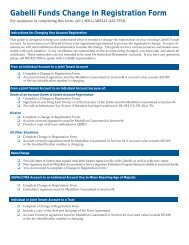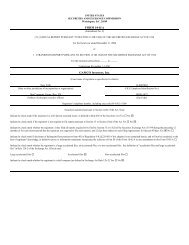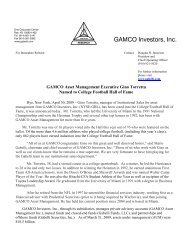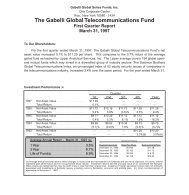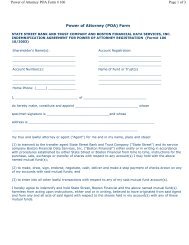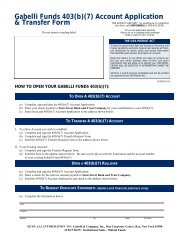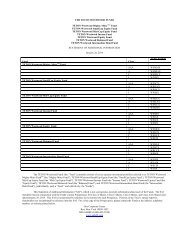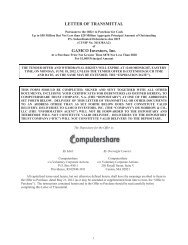Recent Annual Report - Gabelli
Recent Annual Report - Gabelli
Recent Annual Report - Gabelli
Create successful ePaper yourself
Turn your PDF publications into a flip-book with our unique Google optimized e-Paper software.
The <strong>Gabelli</strong> Value Fund Inc.<br />
Notes to Financial Statements (Continued)<br />
many foreign issuers and their markets may be less liquid and their prices more volatile than securities of<br />
comparable U.S. issuers.<br />
Foreign Taxes. The Fund may be subject to foreign taxes on income, gains on investments, or currency repatriation,<br />
a portion of which may be recoverable. The Fund will accrue such taxes and recoveries as applicable, based<br />
upon its current interpretation of tax rules and regulations that exist in the markets in which it invests.<br />
Restricted Securities. The Fund may invest up to 10% of its net assets in securities for which the markets<br />
are restricted. Restricted securities include securities whose disposition is subject to substantial legal or contractual<br />
restrictions. The sale of restricted securities often requires more time and results in higher brokerage charges<br />
or dealer discounts and other selling expenses than does the sale of securities eligible for trading on national<br />
securities exchanges or in the over-the-counter markets. Restricted securities may sell at a price lower than<br />
similar securities that are not subject to restrictions on resale. Securities freely saleable among qualified institutional<br />
investors under special rules adopted by the SEC may be treated as liquid if they satisfy liquidity standards<br />
established by the Board. The continued liquidity of such securities is not as well assured as that of publicly<br />
traded securities, and accordingly the Board will monitor their liquidity. The Fund held no restricted securities<br />
at December 31, 2012.<br />
Securities Transactions and Investment Income. Securities transactions are accounted for on the trade date<br />
with realized gain or loss on investments determined by using the identified cost method. Interest income (including<br />
amortization of premium and accretion of discount) is recorded on the accrual basis. Premiums and discounts<br />
on debt securities are amortized using the effective yield to maturity method. Dividend income is recorded on<br />
the ex-dividend date, except for certain dividends from foreign securities that are recorded as soon after the<br />
ex-dividend date as the Fund becomes aware of such dividends.<br />
Determination of Net Asset Value and Calculation of Expenses. Certain administrative expenses are common<br />
to, and allocated among, various affiliated funds. Such allocations are made on the basis of each fund’s average<br />
net assets or other criteria directly affecting the expenses as determined by the Adviser pursuant to procedures<br />
established by the Board.<br />
In calculating the NAV per share of each class, investment income, realized and unrealized gains and losses,<br />
redemption fees, and expenses other than class specific expenses are allocated daily to each class of shares<br />
based upon the proportion of net assets of each class at the beginning of each day. Distribution expenses are<br />
borne solely by the class incurring the expense.<br />
Custodian Fee Credits and Interest Expense. When cash balances are maintained in the custody account,<br />
the Fund receives credits which are used to offset custodian fees. The gross expenses paid under the custody<br />
arrangement are included in custodian fees in the Statement of Operations with the corresponding expense<br />
offset, if any, shown as “Custodian fee credits.” When cash balances are overdrawn, the Fund is charged an<br />
overdraft fee equal to 2.00% above the federal funds rate on outstanding balances. This amount, if any, would<br />
be included in the Statement of Operations.<br />
Distributions to Shareholders. Distributions to shareholders are recorded on the ex-dividend date. Distributions<br />
to shareholders are based on income and capital gains as determined in accordance with federal income tax<br />
regulations, which may differ from income and capital gains as determined under GAAP. These differences<br />
are primarily due to differing treatments of income and gains on various investment securities and foreign<br />
15




